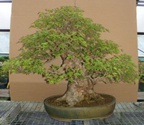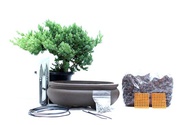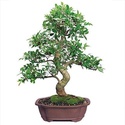The Bonsai tree is an ornamental tree (or shrub!) that is grown in a pot and does not grow to a full-sized tree. They are considered ornamental and artificially dwarfed. Bonsai is an ancient practice, dating back to many Asian cultures and especially in Japan, cultivating small tree growths into pieces of living art. Each bonsai is carefully crafted over decades to embody a virtue or share similarities with human nature. It is common to find award-winning bonsai trees described with sayings “male-like strength” and “powerful.” But what makes them rare and what makes them the most expensive Bonsai Trees in the world?
Some bonsai trunks are stronger than you are
When looking to buy a bonsai, remember: they’re living works of art. Some bonsai trees are hundreds of years old, and the care that went into crafting them will reflect in the price tag. In general, a beginner’s bonsai will run you around $20 at a garden center, and there are many tutorials online that will teach you how to craft your own.
If you’re insistent on shelling out the big bucks for a bonsai that someone else put all the work into, then here are a few things to look for in a quality bonsai:
-
The more mature the bonsai looks, the higher the price, but sturdier the tree
-
No sudden tapering - if the trunk has tapering, it was once a tall tree that has been cut down. A bonsai will have a smooth, uninterrupted trunk & taper gradually
-
The older the pot, the older the bonsai - bonsai are not changed from pot to pot, so if the pot is antique, the tree will more than likely be very rare
Best Seller: $2 Million
In 1981, a 250-year-old juniper sold for reportedly $2 million USD.
Runner-Up: $1.3 Million
The medal for the most expensive bonsai tree ever sold is currently held by a centuries-old Pine that sold for $1.3 million at the International Bonsai Convention in Takamatsu, Japan.
Bronze: $900,000
Third place goes to a hundreds of years old bonsai that was recently on display (and for purchase) at the 8th World Bonsai Convention in Saitama, Japan.
Honorable mention: $90,000
The honorable mention goes to a small, beautiful bonsai that is very old. The trunk is the real showrunner here.
Prices for the rest of us
If you’d like to start to cultivate your own bonsai tree, well-known bonsai blog and enthusiast Bonsai Empire has a starter kit for $39.99. The kit comes with a three-year-old juniper, and the materials you need to begin caring for a bonsai. If you’re a fan of things being delivered to your house (I mean, who isn't?), this Fiscus Bonsai is about $745 from Amazon. Of course, if you want to go for something one-of-a-kind, check out Bonsai Boy's One-of-a-Kind Bonsai collection, including this $12,000 Trident Maple Bonsai Tree.
If you’d like to learn more about Bonsai trees, check out Bonsai Empire, and the website of master grower Kunio Kobayashi.
In terms of growing and cultivating your own bonsai tree, here are some tips for the best life for your bonsai:
-
Trim your tree often
-
Water the bonsai frequently based on the type of tree and your environment
-
Fertilize the bonsai regularly, using nutrients specific to the bonsai’s needs
-
Re-pot the bonsai as necessary, when it has become root-bound or needs the soil refreshed
-
Keep the tree in a location that will encourage growth and longevity
-
Learn how to style it properly, using bonsai-specific pruning and wiring techniques
-
Select the right tree species for your environment. While the juniper and fig tree are the most common types of bonsai trees, there are many other kinds that might be better suited to your environment. The atmosphere, sea level, humidity, soil concentration, and more factors should be weighed when growing or maintaining your own bonsai tree






